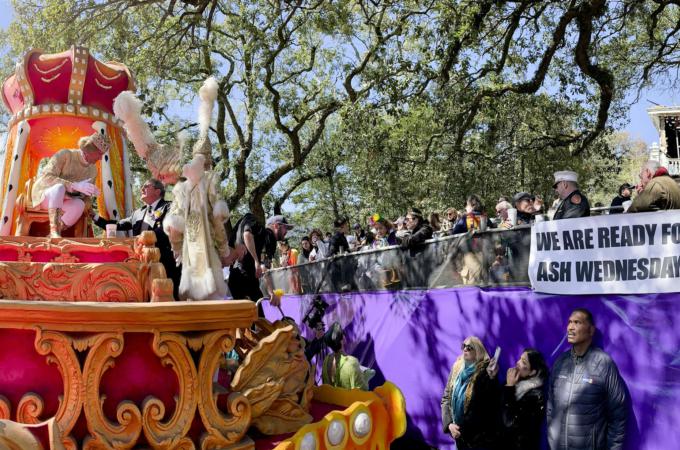The party's over
Ash Wednesday dawns, and here in New Orleans the party is over. Hundreds of elaborate parade floats have returned to the art studio parking lots and warehouses that created them. Krewe members are hanging up their costumes. Revelers are picking through their catches, deciding which to keep and which to give away. The wagons and shade tents, coolers and grills, sling chairs and step ladders no longer line the streets, and the mountains of trash left behind have long been swept away. Thousands of beads hang from the trees; many more thousands will find their way to bead recycling bins. Families are enjoying the rest of school vacation week as tourists fill up their gas tanks and head to Louis Armstrong Airport to fly home. City roads are all open again.
If you haven't been to Mardi Gras in New Orleans, you don't know what you're missing. You also don't know how misleading news reports about this extraordinary city really are. Mardi Gras events don't happen on Bourbon Street, and it isn't a giant frat house party or a modern "bacchanalia." Its culture is much deeper and considerably more fascinating than that. Mardi Gras in New Orleans is the ultimate community venture. There are no government or corporate sponsors; in fact, none are allowed. And it is predominantly family-friendly.
Everything is organized, hosted, and executed by private groups of citizens known as Krewes -- each with its own character and style. Love music? The Krewe of Orpheus might be for you. Professional women? Muses. Political Satire? Le Krewe d'Etat. Wine? Bacchus. Dog lovers? Barkus. SciFi? Chewbacchus. The tradition of wearing masks makes it possible for people of all backgrounds -- especially those who travel in different circles -- to parade together.
Most krewe memberships require a substantial investment of both time and money. Annual dues of $1,000 are not uncommon, and that doesn't include the $1,000 average cost per member of items that are thrown to the crowds. Many krewe members work all year on their handmade signature throws, things like Zulu's decorated coconuts, Muses bedazzled high heel shoes, purses from Nyx, and boxes from Pandora. Crazy? Maybe. But if you love your culture, you know that keeping it alive doesn't just happen. It takes sacrifice and commitment to preserve what you've been given and hand it down to the next generation.
I think the most difficult thing to imagine is the sheer scale of what goes on here. Mardi Gras isn't a day or two; it's a season that starts with Epiphany on Jan. 6 and builds toward Ash Wednesday. Once Christmas is over, purple, gold, and green are everywhere, as are king cakes of many styles and over 20 flavors. By 8:00 a.m. the line at Manny Randazzo's is two blocks long. The first parade of the season honors the city's patron saint, St. Joan of Arc, on her birthday. Krewe Jeanne D'Arc marches in medieval attire through the French Quarter at dusk. A teenaged girl chosen as the "Maid of Honor" rides a horse dressed as St. Joan, and a blessing of the sword ceremony occurs at the cathedral. Instead of beads, parade watchers are likely to receive prayer cards, battery operated candles, and bookmarks.
In the last two weeks, the parades intensify. This year, there were 70 parades in the area. They are held both day and night. The largest and longest have 30 or more floats interspersed with marching bands and other groups. Some parades march one after another. We spent eight hours watching Zulu and Rex. From the nine parades we attended this year, we accumulated four large plastic storage boxes of stuff. That includes 40 pounds of beads!
On a spiritual level, New Orleans Mardi Gras culture has given me a lot to think about. Living our faith in an age of scandal and amidst a culture of aggressive godlessness, it's easy to lose sight of the fact that Christianity gives us all reason to celebrate. It can be hard to remember that it is possible to experience our faith as a source of unbridled and exuberant joy. Even here. Even now.
At the risk of upsetting ecclesiologists, I can imagine that the Church might just be like one huge Mardi Gras. We each find our spirituality -- our krewe to ride with. We gather from every race, culture, time, and place. We take the streets and meet the people near us. We are delighted and amazed by the colorful beauty we see and stretch our necks to get a glimpse of the king and queen. We wait with anticipation to catch the graces that are thrown to us. We cheer and shout and sing and dance and march together along the route to heaven, where joy never ends.
- Jaymie Stuart Wolfe is a Catholic convert, wife, and mother of eight. Inspired by the spirituality of St. Francis de Sales, she is an author, speaker, and musician, and serves as a senior editor at Ave Maria Press. Find Jaymie on Facebook or follow her on Twitter @YouFeedThem.



















